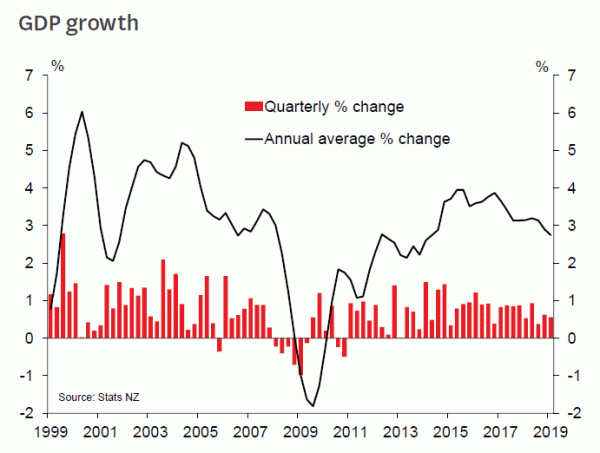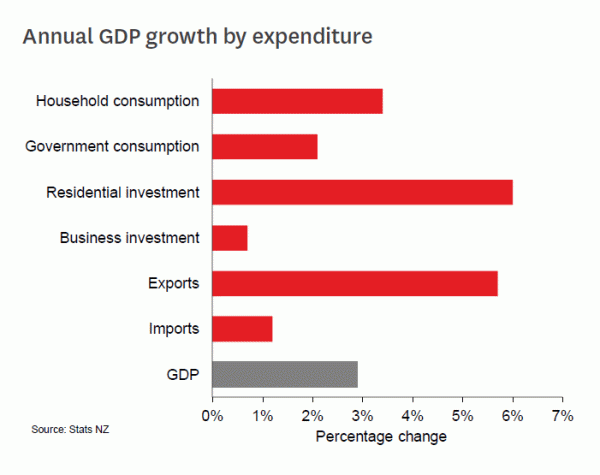- GDP rose by 0.6% in the March quarter, in line with market forecasts.
- There were strong gains in construction, mining and food manufacturing, though the risk is that some of these gains are reversed in the next quarter.
- Growth in the service sectors was subdued in most cases.
- Today’s result was ahead of the Reserve Bank’s already-low forecast, and should be enough to leave it in data watching mode for now.
The New Zealand economy expanded by 0.6% in the March quarter, which was in line with our view and with market forecasts. There were some small upward revisions to the previous two quarters, which lifted the annual growth rate to a slightly stronger than expected 2.5%.
The pace of growth has slowed from its peaks in the last couple of years. We put this down mostly to domestic factors: the unwinding of the Canterbury rebuild, the cooling in the housing market, and more recently, low confidence weighing on firms’ hiring and investment plans. The latter in particular will not be alleviated quickly. However, we do expect growth to accelerate over the next year or so. Interest rates are low, government spending is ramping up, and there is a substantial amount of building work in the pipeline.
The Reserve Bank had already braced itself for some nearterm softness in GDP, forecasting a 0.4% quarterly increase in its May Monetary Policy Statement. Today’s result should give the RBNZ some comfort about the state of the economy, though it will be tempered by the fact that June quarter indicators have so far been subdued. We’ll discuss what to expect from next week’s OCR review in our preview bulletin tomorrow.
Turning to the details of today’s release, the breakdown by sector was broadly in line with our forecasts. Construction and food manufacturing made strong gains for the quarter, but growth elsewhere was patchy.
The result was slightly flattered by a 9.6% jump in the mining sector. While there was a lift in oil and gas extraction over the quarter, much of this gain likely reflects exploratory drilling at the Kohatukai field, which has since ended without success. Consequently, this will be a drag on growth in the next quarter.
Construction activity rose by 3.7%, with strong gains in both residential (+2.7%) and non-residential building (+9.9%). Building consents are clearly pointing to a strong pipeline of building work for the next year, though it was surprising to see how much of it came through in the March quarter. The result was tempered by another steep fall in civil construction (-6.4%), which in part reflects the wind-down of quake-related repairs.
Food manufacturing rose by 3.8% for the quarter. While dry conditions weighed on both agricultural output and dairy processing, this was more than offset by strong gains in areas such as fruit and beverages. The latter can be quite jumpy, and the risk is for an unwind in the next quarter.
The service sectors were subdued overall, with growth of just 0.2%. Retail rose by a modest 0.5%, accommodation was dragged down by a drop in tourist numbers, real estate services fell as house sales slowed, and telecommunications fell by 0.6%. Even government services were up just 0.2%, after strong growth in previous quarters. The exception to the services sector weakness was healthcare, with a 1.7% rise.
The expenditure measure of GDP was a little more positive, rising by 0.8% in the March quarter. While this measure is considered less reliable on a quarterly basis, its recent trends perhaps provide a clearer demonstration of what has driven the slowdown in growth.
On the plus side, household spending has continued to growth at a modest pace but is down from the peaks of a few years ago, matching the slowdown in house prices and the subsequent effect on housing wealth. Government spending has also been providing support, though it has tended to fall behind what was planned. Housing construction, while already operating at a high level, has found some fresh legs in the past year.
In contrast, business investment has been relatively subdued – even more so if we take out building work. Investment in plant and machinery has been flat to falling over the last year, after having been an important source of growth in previous years.

















